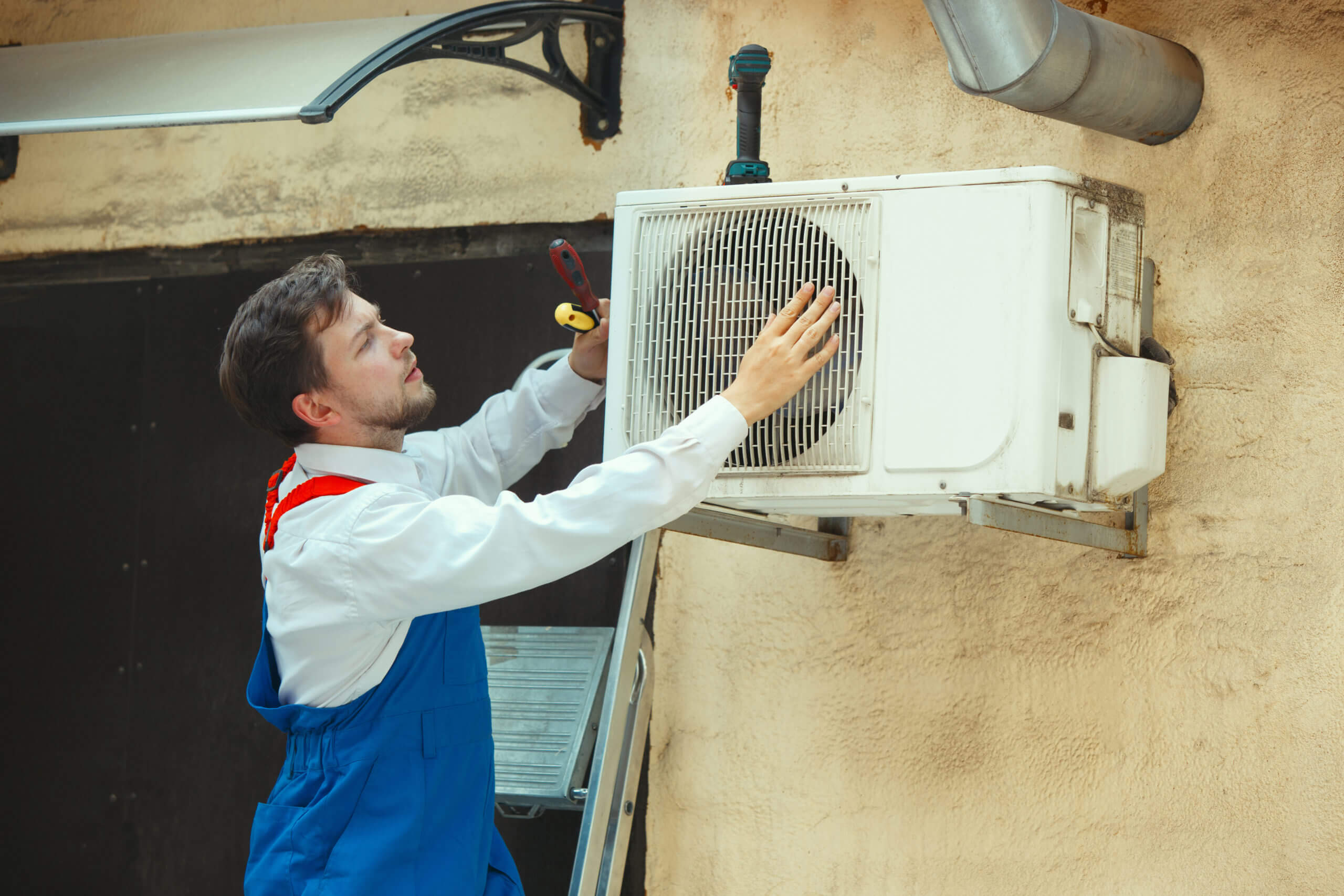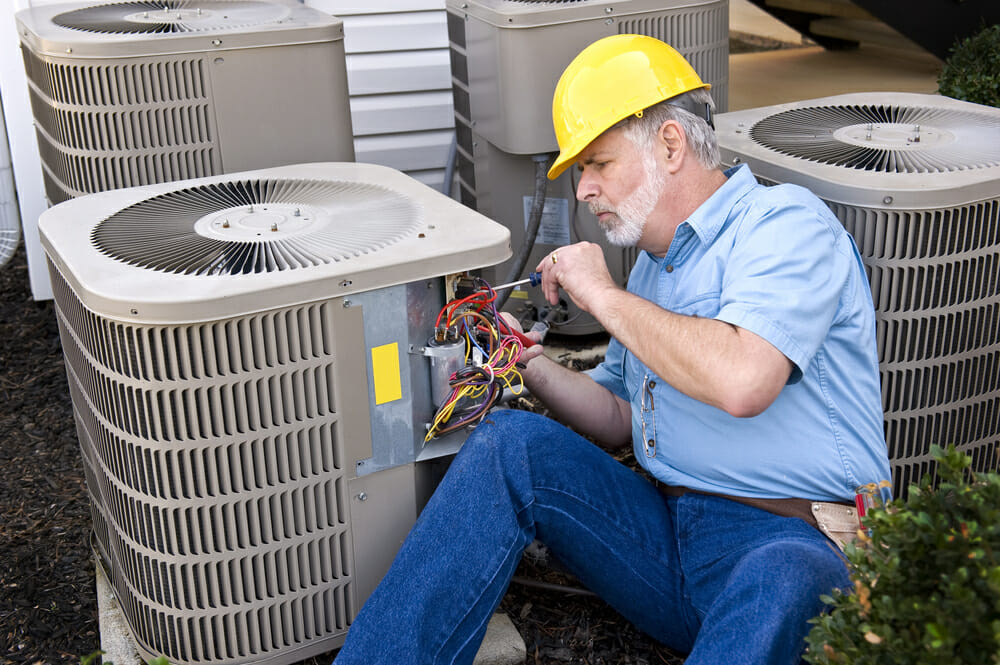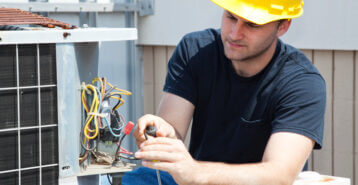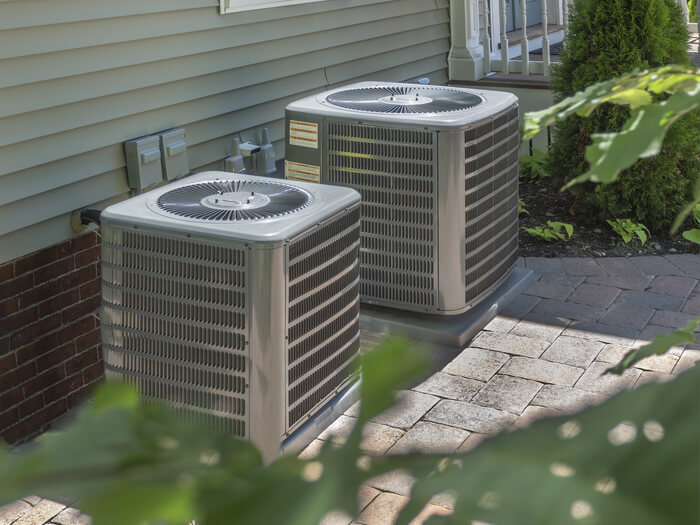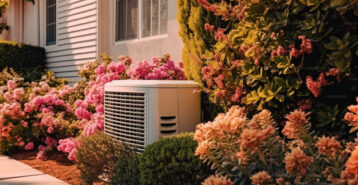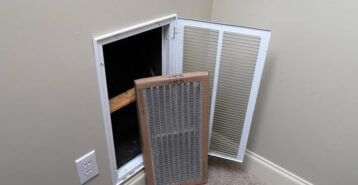HVAC Maintenance: What to Know
The benefits of annual preventive HVAC maintenance checkups on your central air-conditioning system far outweigh the costs of repair service. With regular preventive maintenance checkups, you can expect:
- Peak performance from your central air conditioning system.
- Increased energy efficiency as a finely tuned and maintained unit will consume less energy, reducing your energy costs.
- Early warning of potential equipment failures in the future.
- A peace of mind knowing your home’s central air conditioning system is in A1 condition and using energy efficiently.
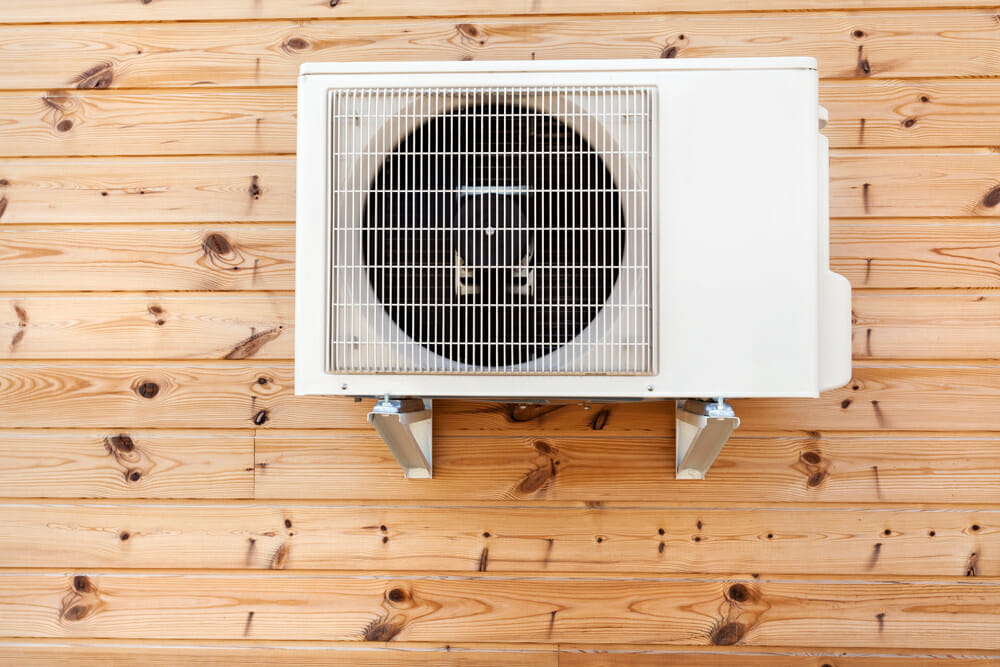
Annual preventive HVAC maintenance contracts are great but sometimes trouble arises in between appointments. Although most central air conditioning repairs require a professional, there are some things you can do to troubleshoot and even correct your home’s system.
- When your system loses its power, check for tripped breakers or blown fuses in the circuit breaker box. However, use extreme caution when working around electricity.
- If the system is running but not cooling, try lowering the thermostat settings by 5 degrees.
- The system is running but air is not coming out of the vents. Check for a dirty filter and replace if necessary. A dirty filter can lead to ice forming on the evaporator coil, which will prevent airflow.
- Clean the evaporator coils. A dirty evaporator coil can also lead to ice forming on its coil, prohibiting airflow. Find detailed instructions below.
- Inspect the condenser outside unit coils for dirt, debris and vegetation that can impede airflow to the compressor. If the compressor cannot breath, it could overheat and shut down.
Homeowner HVAC Maintenance Checklist
- Change out HVAC Filters
- Clean HVAC Unit Returns & Registers
- Maintain Your HVAC’s Exterior Components
- Make sure your home is sealed properly
Changing Out HVAC Filters
Changing the filters regularly is one of the most important steps to maintaining your HVAC system and can be handled by most homeowners easily. Dust, dirt and other debris will gradually reduce the filter’s airflow until it eventually becomes so clogged it is detrimental to the system. When this happens, you HVAC system and related equipment must work harder to circulate the conditioned air. The additional strain leads to premature equipment failure and costly repairs. In addition, the system will also use more energy, which will increase your monthly utility bill.
Clean Returns and Registers on Your HVAC Unit
Dirty returns and registers can introduce dust, dirt and other debris into your HVAC system. As a result, your filter and/or coil can become contaminated and experience reduced airflow. Periodically clean all air returns and registers to reduce the amount of dust build up from entering your HVAC system.
Maintain Exterior HVAC Components
HVAC systems that utilize an outside component such as a condensing — compressor — unit should be inspected periodically to ensure that the unit is not obstructed. Prevent grass, weeds and other foliage from blocking the airflow to the unit. Restricted airflow causes additional strain on the system, which can lead to reduced energy efficiency and costly repairs due to excessive wear and tear. In addition, dirt, sand and leaves can build up around the exterior condensing coil and reduce airflow. You can address this problem by gently rinsing the exterior condensing coil with a garden hose.
Maintain a Tight Envelope
Your home’s envelope — its ability to maintain conditioned air — is a vital component to HVAC efficiency. Many utility companies offer free or reduced home energy audits that gauge your home’s energy efficiency. The audits are a useful service that can identify areas of your home that fall short. These could include inadequate insulation, leaking windows and doors or cracks and crevices in exterior walls that allow conditioned air to escape.
HVAC Maintenance by Contractors
A licensed contractor can help maintain your HVAC system by performing the following steps annually:
- Lubricate all Moving Parts: Without the regular lubrication, the moving parts within your HVAC system will experience increased friction, which leads to decreased performance and efficiency. In addition, the parts can succumb to premature failure, which leads to costly HVAC repairs.
- Check Refrigerant Levels: Improper refrigerant levels can reduce system efficiency and/or damage internal parts such as the compressor.
- Inspect Electrical Connections: Verify that all electrical connections are tight and in good working order.
- Inspect Condensation Lines: A blocked or restricted condensation line can cause your system to overflow and/or leak water. If this happens, you are at risk of higher humidity levels, mold and/or mildew growth and the potential of water damage in your home.
- Clean the Coils: Coil cleaning, both inside and out, is an important step in air conditioning maintenance. Similar to a dirty filter, a dirty coil will reduce the system airflow, drive up energy costs and put more strain on the system.
- Inspect and Calibrate Thermostat: A faulty thermostat can give false temperature readings leading to reduced system efficiency and higher energy costs.
- Tighten Fuel Line Connections: Leaking fuel lines present both a safety hazard and reduced system efficiency through increased fuel costs.
- Clean Burners: When soot and other debris accumulate on the burner, it can cause pilot light malfunctions and reduced system efficiency.
- Inspect Heat Exchangers: A cracked heat exchanger can prevent the system from reaching maximum heating capacities.
- Inspect Furnace Exhaust Outlets: An obstructed, restricted or compromised exhaust outlet presents a major safety concern as the dangerous build up of carbon monoxide and other harmful gasses can occur.
You can read our HVAC contractor checklist to vet contractors before you hire them for your HVAC project.
How to Clean AC Coils
If you forgot to change the filter or ran your system without one, which happens more often than you would think, your evaporator coils might have gotten dirty. Therefore, you find yourself six months before your next scheduled cleaning and HVAC maintenance call wondering what to do. No sweat, most homeowners should have no trouble cleaning their evaporator coils themselves and preventing a costly service call. Gather the following items before starting this project:
- A bottle of coil cleaner sold at most hardware, AC supply houses or home improvement centers. If you are unable to locate the coil cleaner, a household bathroom cleaner such as scrubbing bubbles will suffice.
- Protective gear such as safety goggles and rubber gloves.
- A drop cloth to protect flooring.
- A flashlight.
- Two plastic spray bottles.
- A wet/dry vacuum cleaner.
- Clean rags.
Step 1. Turn the power off to the central air conditioning system at the circuit breaker box.
Step 2. Remove the air filter on the evaporator unit to expose the underside — the side most exposed to dirt and debris collection — of the evaporator coils.
Step 3. Clean the area beneath the evaporator when applicable and vacuum as much of the loose debris from the evaporator coils as possible.
Step 4. Mix the coil cleaner when applicable with clean water according to manufacturer’s instructions. Some coil cleaners might not require mixing with water so read the instructions carefully.
Step 5. Apply the solution liberally to the evaporator coils using the spray bottle. Be sure to wear your safety goggles and rubber gloves to prevent injury.
Step 6. Rinse the evaporator coils with clean water using a plastic spray bottle.
Step 7. Vacuum entire area and wipe up excess solution, dirt or debris with clean rags.
Step 8. Install a new filter.
Seasonal Winter HVAC Maintenance
- Prepare Your Fireplace
- Improve Insulation
- Hire an HVAC Tech Before Winter
Plunging temperatures and wintry weather can be rough on your heating equipment—and there’s nothing worse than waking up on a cold morning to find out your heater’s given out.
And then there’s the issue of your heating bills. Ill-maintained equipment is often inefficient. And that can cause heating expenses to skyrocket. A little preventative maintenance can save you a lot in the long run — but only if you act fast. Here’s how to keep yourself in the clear all the way until spring.
Prep Your Fireplace
A fireplace is a cheery source of heat on a cold winter’s day, but only when they’re kept up with regular TLC. You should have a chimney sweep performed at least once a year. Professional chimney cleaners can remove creosote buildup — a mixture of tar, soot, and debris — which can ignite and cause fire damage if not properly treated. Sweeps should also inspect the chimney liner and outer structure for cracks — the openings that contribute to drafts in your home. Expect to spend $125 to $250 for each visit.
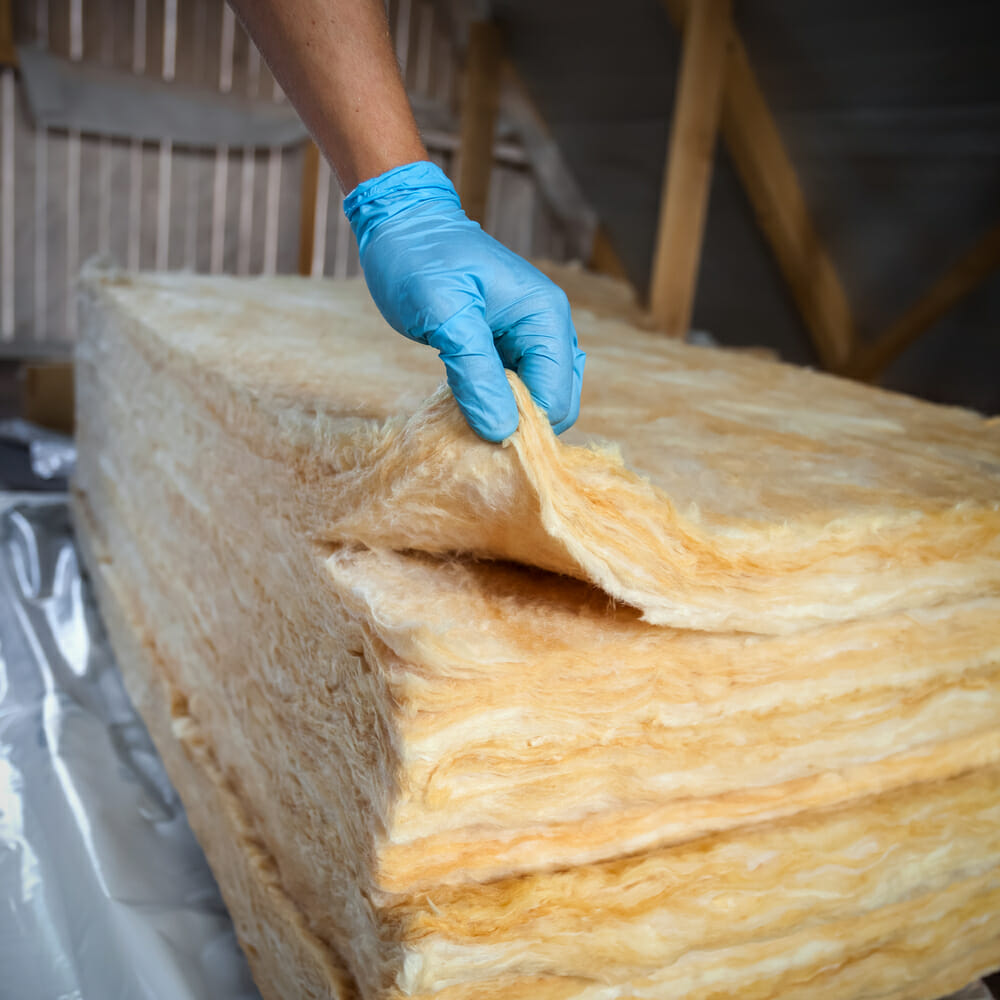
Improve Your Home’s Insulation
Your home’s heating amounts to a lot more than just a furnace. It’s a complicated system made out of vents, ducts, wiring, and registers — all of which operate more efficiently in a home that’s properly insulated. Take a moment to inspect your insulation, particularly in your attic and crawl space. Look for water damage on the ceiling and attic walls, because water infiltration can render insulation ineffective. If you have questions about your insulation, you may want to hire a contractor to perform a professional insulation inspection. Inspectors will measure airflow, and they can tell if your insulation has gaps or is inadequate. They’ll also seek out signs of pests like rodents and roaches, critters that love to stow away in attics during cold weather.
HVAC Inspections Before Winter Comes
Because HVAC systems are complicated, it’s good to get some help from the pros. A professional service visit from an HVAC technician gives you expert-level inspection from a trained specialist. During these service visits, technicians check the wiring and look for damage and clogs in your unit and ducts. They’ll also seek out holes and fissures that can lead to carbon monoxide leaks, which makes these inspections extra valuable to your family’s health and happiness. Last of all, HVAC inspectors make recommendations for how to get your system more energy efficient, such as improvements to ducts and duct insulation, air sealing, and ventilation. Fixes like these could save you hundreds each year in reduced energy costs
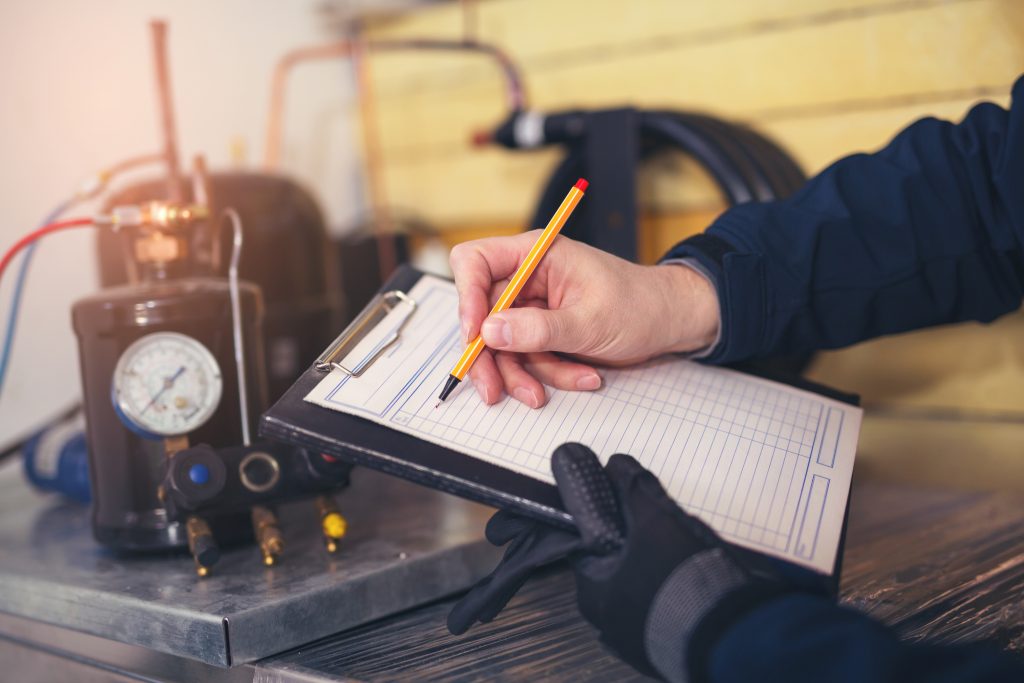
Modernize now offers homeowners a free, digital Contractor Checklist as a simple, step-by-step guide to assist with your HVAC repair or replacement. You can also refer to our HVAC Financing Checklist to plan your HVAC project at each step to stay under budget or use external sources when needed.
Compare top-rated HVAC pros in your area.
Read real homeowner reviews, explore qualifications, and view promotions. Modernize makes it easy to browse professionals and find one that will be perfect for your project.
